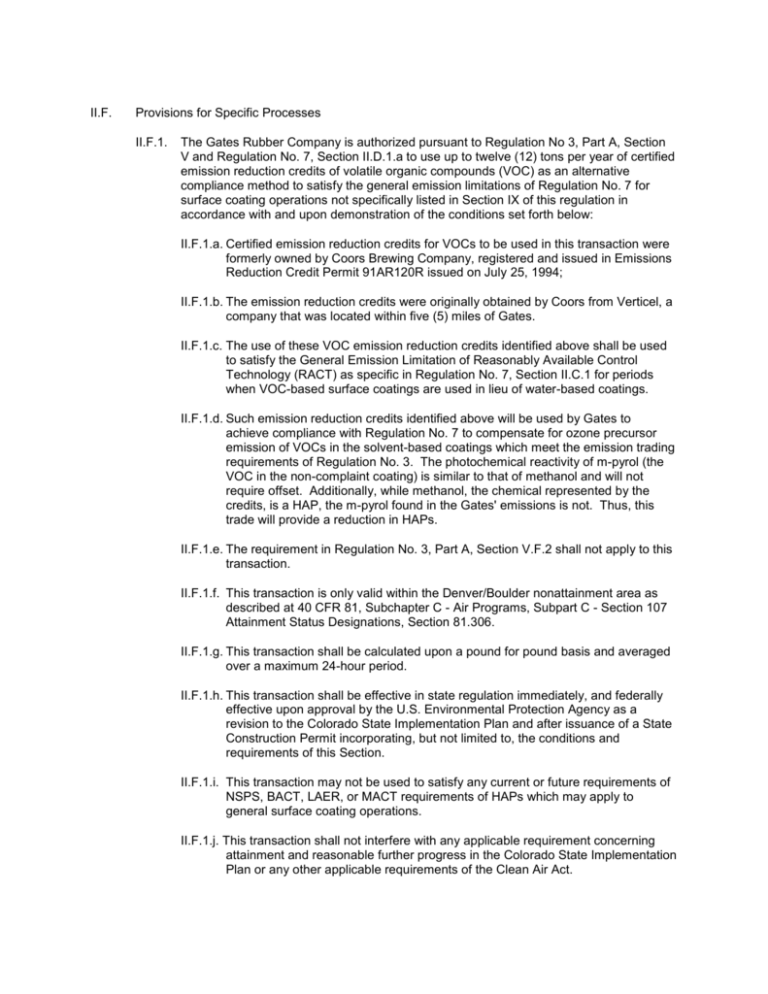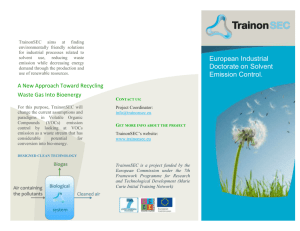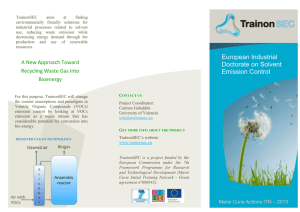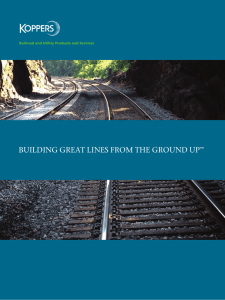ProposedRuleAttach2008
advertisement

II.F. Provisions for Specific Processes II.F.1. The Gates Rubber Company is authorized pursuant to Regulation No 3, Part A, Section V and Regulation No. 7, Section II.D.1.a to use up to twelve (12) tons per year of certified emission reduction credits of volatile organic compounds (VOC) as an alternative compliance method to satisfy the general emission limitations of Regulation No. 7 for surface coating operations not specifically listed in Section IX of this regulation in accordance with and upon demonstration of the conditions set forth below: II.F.1.a. Certified emission reduction credits for VOCs to be used in this transaction were formerly owned by Coors Brewing Company, registered and issued in Emissions Reduction Credit Permit 91AR120R issued on July 25, 1994; II.F.1.b. The emission reduction credits were originally obtained by Coors from Verticel, a company that was located within five (5) miles of Gates. II.F.1.c. The use of these VOC emission reduction credits identified above shall be used to satisfy the General Emission Limitation of Reasonably Available Control Technology (RACT) as specific in Regulation No. 7, Section II.C.1 for periods when VOC-based surface coatings are used in lieu of water-based coatings. II.F.1.d. Such emission reduction credits identified above will be used by Gates to achieve compliance with Regulation No. 7 to compensate for ozone precursor emission of VOCs in the solvent-based coatings which meet the emission trading requirements of Regulation No. 3. The photochemical reactivity of m-pyrol (the VOC in the non-complaint coating) is similar to that of methanol and will not require offset. Additionally, while methanol, the chemical represented by the credits, is a HAP, the m-pyrol found in the Gates' emissions is not. Thus, this trade will provide a reduction in HAPs. II.F.1.e. The requirement in Regulation No. 3, Part A, Section V.F.2 shall not apply to this transaction. II.F.1.f. This transaction is only valid within the Denver/Boulder nonattainment area as described at 40 CFR 81, Subchapter C - Air Programs, Subpart C - Section 107 Attainment Status Designations, Section 81.306. II.F.1.g. This transaction shall be calculated upon a pound for pound basis and averaged over a maximum 24-hour period. II.F.1.h. This transaction shall be effective in state regulation immediately, and federally effective upon approval by the U.S. Environmental Protection Agency as a revision to the Colorado State Implementation Plan and after issuance of a State Construction Permit incorporating, but not limited to, the conditions and requirements of this Section. II.F.1.i. This transaction may not be used to satisfy any current or future requirements of NSPS, BACT, LAER, or MACT requirements of HAPs which may apply to general surface coating operations. II.F.1.j. This transaction shall not interfere with any applicable requirement concerning attainment and reasonable further progress in the Colorado State Implementation Plan or any other applicable requirements of the Clean Air Act. II.F.1.k. This transaction shall be registered and enforced through a federally-enforceable permit issued to The Gates Rubber Company containing, but not limited to, the conditions and limitations set forth in this Section. II.F.1.l. Such federally-enforceable permit issued to The Gates Rubber Company shall specify, among other things, the necessary monitoring, record keeping, and reporting requirements to insure that the emission reduction credits are applied in accordance with the condition and requirements of this Section. II.F.1.m. The federally-enforceable permit shall allow a daily maximum limitation of 400 lbs. of VOC and an annual limitation of no more than 24,000 lbs. of VOC emissions from the use of uncontrolled solvent-based coatings in lieu of waterbased coatings on Gates' 10 Cord line (identified as S033, S034, and S035). The limitation shall be calculated on a 12-month rolling total calculated within 30 days of the end of each month using the previous 12 months. None of these incremental emissions allowed in lieu of RACT will be HAPs. II.F.1.n. Gates will maintain records of daily and monthly totals of VOC-based surface coatings used in first zone of the 10 Cord coating line and report such usages on an annual basis to the Division or as otherwise requested. II.F.2. Koppers Inc. is authorized to install and operated a Division-approved scrubber system at the wood treatment facility located at 465 West 56th Avenue, Denver, Adams County, Colorado, as an alternative compliance method to the general emission control requirements of Regulation Number 7, Sections III.A. and IIII.B. on selected tanks. Koppers Inc. shall achieve compliance with Regulation Number 7 by either connecting the affected tanks to the Division-approved scrubber or operating the affected tanks consistent with Sections III.A. and III.B. XVII.I. (July 17, 2008, Section II.F.) This Statement of Basis, Specific Statutory Authority and Purpose complies with the requirements of the Colorado Administrative Procedure Act Sections 24-4-103(4), C.R.S., for new and revised regulations. Basis Regulation No. 7, Sections III.A and III.B impose general emission control requirements on tanks located in the Denver Ozone Attainment/Maintenance Area. Commission Regulation No. 7, Section III.A states, in part, that all “storage tank gauging devices, anti-rotation devices, accesses, seals, hatches, roof drainage systems, support structures, and pressure relief valves shall be maintained and operated to prevent detectable vapor loss”. Commission Regulation No. 7, Section III.B requires that all VOCs “transferred to any tank, container, or vehicle compartment with a capacity exceeding 212 liters (56 gallons), shall be transferred using submerged or bottom filling equipment.” The current revision creates a provision for processes specific to the Koppers Inc. wood treatment facility located in Adams County, Colorado (“the Facility”). The addition of a provision specific to the Facility is based on reasonably available, validated, reviewed and sound scientific methodologies and assumptions. Evidence in the record supports the finding that the rule shall result in a reduction in air pollution, and will reduce the risk to human health or the environment or otherwise provide benefits justifying the costs. Among the options considered, the regultory option chosen will maximize air quality benefits in the most cost-effective manner. Specific Statutory Authority The specific statutory authority for these revisions is set forth in Section, 25-7-105(1)(a), C.R.S., which gives the Air Quality Control Commission authority to promulgate rules and regulations necessary for the proper implementation of a comprehensive state implementation plan that will assure attainment of national ambient air quality standards. Additional authority for these revisions is set forth in Sections, 257-106 and 25-7-109, C.R.S., which allow the Commission to promulgate emission control regulations and recordkeeping requirements applicable to air pollution sources. Specifically, Section 25-7-106(1)(c), C.R.S., authorizes the Commission to adopt emission control regulations that are applicable to specified areas within the state. Section 25-7-109(1)(a), C.R.S., authorizes the Commission to adopt emission control regulations. Section 25-7-109(3)(b), C.R.S., authorizes the Commission to adopt emission control regulations for the storage and transfer of petroleum products and any other volatile organic compounds. Purpose The Revision to Section II.F was adopted in order to provide flexibility to Koppers Inc. to reduce and control volatile organic compound emissions in the most cost-effective manner from the wood treatment facility located at 465 West 56th Avenue, Denver, Adams County, Colorado (“the Facility”). The Facility is subject to Regulation No. 7, Sections III.A and III.B regarding operation of tanks in compliance with RACT. The Division and Koppers have agreed that the installation and operation of a Division-approved scrubber at the Facility will reduce VOC emissions equivalent to or to a greater extent than the requirements in Regulation No. 7, Sections III.A and III.B. The Commission understands that Koppers will either ensure the affected tanks are connected to a Division-approved scrubber or comply with Regulation No. 7, Sections III.A and III.B. The specific terms and conditions will be included in the construction permit issued to Koppers Inc. The requirements in this rulemaking take effect on July 31, 2008. COLORADO AIR QUALITY CONTROL COMMISSION ADOPTED: July 17, 2008









